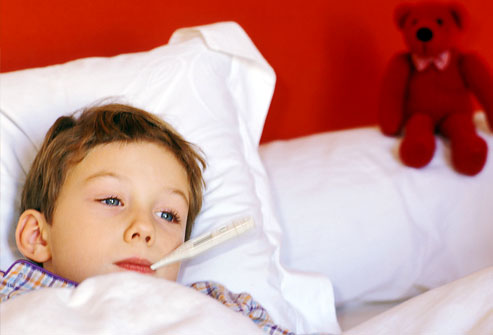Keep cool with a high fever and febrile seizures in infants
When the immune system has to deal with pathogens, the self-healing of the body is often supported with fever. If fever is also a natural and very sensible defensive reaction, so high fevers and febrile convulsions should be closely monitored in infants and taken seriously.
 Of febrile seizures that occur only when the fever thermometer reads 39 degrees Celsius, mostly babies and toddlers aged 6 months to 5 years are affected.
Of febrile seizures that occur only when the fever thermometer reads 39 degrees Celsius, mostly babies and toddlers aged 6 months to 5 years are affected.
Where boys get frequent febrile seizures than girls. Who witnessed a febrile seizure of a small child for the first time, will be very scared and worried. Especially parents react anxious and panicky, because they are often perplexed and overwhelmed. Do not know how to deal with the situation. For a febrile seizure plagued by child can fall into unconsciousness with upturned eyes. Often arms and legs are stiff and start to twitch as epileptic seizures. Despite the great terror to get the parents on the first occurrence of such a febrile seizure in their child is calm and reason demand. It is especially important to pay attention in these moments that the child during the febrile seizure can not hurt.
What you should know about febrile seizures in infants.
In young children, the fever is rising much faster than adults and climbs in no more than 38 degrees. Fortunately, however, the high fever occurs with the insidious seizures in otherwise healthy children quite rare. Only about 4 percent of all children are visited during their most recent years of febrile seizures. Most dissolves the cramp after a few minutes away by itself to, making it one of the more harmless waveform. However, the duration and intensity of seizures should be closely monitored. Does the spasm longer than 15 minutes, an ambulance should definitely be taken during the febrile seizure. Only a doctor can be determined from the symptoms described by the parents, whether the course of the seizure is classified as harmless or whether it is a complicated febrile seizure. In any case applies, the child after the first occurrence of a febrile seizure to investigate the pediatrician imagine. Also infections, such as Salmonella can cause a febrile seizure.
On these symptoms you should look.
Feels your child’s body temperature to hot and the fever is rising very rapidly to about 39 degrees, which may be the precursor to a febrile seizure. Furthermore, the reaction may subside and the child is unresponsive. Watch out for the eyes of your child. A stare or even rolled eyes may precede a brief loss of consciousness. Arms and legs twitch uncontrollably for several minutes can suddenly as epileptic seizures. If the seizure over, the child is slow to recover properly located. It is tired and can not usually the spasm remember.